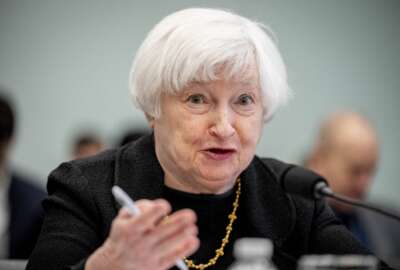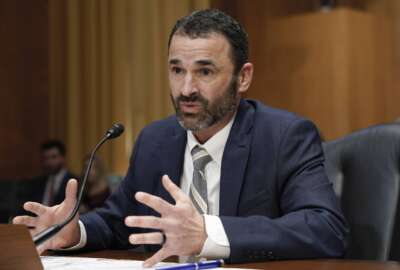IRS reorganizes its top ranks, with focus on ‘historic’ agency modernization
The Internal Revenue Service is shaking up its leadership team for the first time in decades to elevate parts of the agency at the center of a multi-billion-dol...
The Internal Revenue Service is shaking up the structure of its leadership team for the first time in decades.
The IRS reorganization is meant to elevate parts of the agency at the center of a multi-billion-dollar modernization agenda.
The IRS is consolidating its two deputy commissioner roles into one position, giving the agency a single second-in-command official.
The agency is also creating four new “chief” roles to prioritize mission areas that are the focus of the roughly $60 billion available under the Inflation Reduction Act to rebuild its workforce and modernize its IT.
These new roles will prioritize improvements in taxpayer services, tax compliance, IT and operations.
IRS Commissioner Danny Werfel told reporters the reorganization is the agency’s first major leadership reshuffle in 20 years.
“We have wave after wave of change coming that will improve and update our agency operations,” Werfel said in a call Wednesday. “And we’ve spent a lot of time thinking about the best way to approach these changes, not just from an operational standpoint, but from a management standpoint.”
The IRS saw its last major structural change in 2000 under the 1998 Restructuring and Reform Act.
“The changes will streamline operational efficiencies and align with major transformation work underway at the agency through the Inflation Reduction Act funding,” Werfel said.
Werfel said the agency saw “minimal changes” to its leadership structure in the following years, such as the addition of a second deputy IRS commissioner in 2003.
“This new governance model better supports the agency’s mission, as well as giving heightened importance to these four key areas of taxpayer service, tax compliance, IT and operations,” Werfel said. “These are critical areas we need to focus on, and this structure will reflect those priorities.”
The roots of this IRS reorganization started in January 2021, when Congress passed the Taxpayer First Act. Under that legislation, the IRS launched its Taxpayer Experience Office in March 2022.
“By any measure, this is a historic time for the IRS. In light of these historic changes, the IRS leadership team and I have been giving a lot of thought on the best way to approach this,” Werfel said.
Among the upcoming changes, the IRS is elevating the work of its Chief Information Officer Rajiv Uppal.
Werfel said the CIO’s office previously worked under its operations support division, a branch that also includes the agency’s human resources, finance and procurement functions.
“By splitting information technology out and elevating the chief information officer to be on the same level with the other chiefs, it creates greater connectivity and visibility that the commissioner’s office has into our technology, creates more accountability and better ongoing communication around risks and opportunities in the technology space.”
Ken Corbin, the IRS’ current wage and investment commissioner, and its chief taxpayer experience officer, will serve as the agency’s new chief of taxpayer service.
The IRS is also tapping Melanie Krause, its current chief data and analytics officer, to take on a larger portfolio of work as chief of operations.
Among her additional duties, Krause will oversee the IRS Human Capital Office and its Chief Financial Office, as well as its procurement, facilities management and security services.
Heather Maloy, the current IRS chief of staff, will serve as the agency’s first chief taxpayer compliance officer.
“It’s critical for the very top of the organization to be aligned with these efforts to help our workforce, and help ensure we are doing everything as quickly and efficiently as we can,” Werfel said.
Werfel said the new chief taxpayer compliance officer role will centralize some functions that were scattered across offices overseeing tax compliance for large businesses, small businesses, and tax-exempt organizations.
“The reality is that elements of what they do, from an enforcement standpoint, are appropriately separate, but there are common denominators around hiring and skill sets — technology, data and analytics subject-matter expertise — that they need and would benefit the entire effort if we could strengthen coordination across these divisions,” Werfel said.
Doug O’Donnell, the current deputy commissioner for services and enforcement, will serve as the agency’s sole deputy commissioner.
Jeff Tribiano, IRS deputy commissioner for operations, is leaving the agency for another Senior Executive Service (SES) position in government.
Werfel said Tribiano spoke to him about leaving the agency in March, but asked him to stay on while Werfel started his tenure as commissioner.
“Jeff and I spoke, and agreed that he had made this commitment to me, and that he should begin his transition to a new SES role in government,” Werfel said. “The fact that Jeff had decided to leave the IRS allowed us to look at different models of how we might want to proceed.”
The IRS expects to put its reorganization plan into effect in early 2024.
Werfel said the leadership changes would have “virtually no day-to-day impact” on IRS employees, and would just impact the reporting structure for the agency’s top positions.
The agency also plans to work with Congress and the National Treasury Employees Union to implement these changes.
Werfel said the IRS notified Congress about the agency restructuring but does not need congressional approval to make the changes.
“The changes that we are announcing today, that we’re planning to do, will not have any changes to our budgetary appropriations. Therefore, under the law, the requirements are a notification, and we’ve started that process,” he said.
Copyright © 2024 Federal News Network. All rights reserved. This website is not intended for users located within the European Economic Area.
Jory Heckman is a reporter at Federal News Network covering U.S. Postal Service, IRS, big data and technology issues.
Follow @jheckmanWFED






